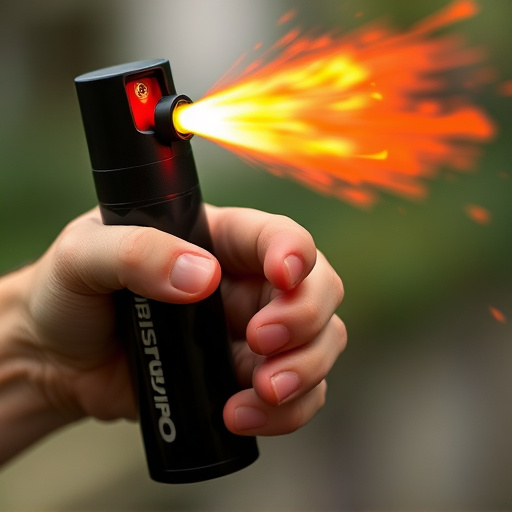Pepper spray canisters, designed for non-lethal self-defense, effectively deter aggressive dogs by irritating their eyes and respiratory system through capsaicin, a compound derived from chili peppers. When used properly, pepper spray provides users with crucial time to escape dangerous situations. Specialized products for canine confrontations, featuring high capsaicin concentrations and precise application methods, are recommended. Responsible use requires training in de-escalation techniques, understanding active ingredients, health risks, activation, aiming, and safe distances, ensuring the safety of both humans and animals.
“Uncover the power of pepper spray canisters as a vital tool in defending against aggressive dogs. This comprehensive guide explores the science behind these devices, their composition, and effectiveness in deterring canine attacks. We delve into the specific role of pepper spray in dog defense strategies, offering insights on its mechanism of action. Additionally, we provide expert advice on selecting the appropriate pepper spray for different scenarios, ensuring safety through proper precautions and training. Discover how responsible use can enhance personal safety during encounters with potentially dangerous dogs.”
- Understanding Pepper Spray Canisters: Their Composition and Effectiveness
- The Role of Pepper Spray in Dog Defense: How It Works
- Choosing the Right Pepper Spray for Dog Confrontations
- Safety Precautions and Training: Responsible Use of Pepper Spray Canisters
Understanding Pepper Spray Canisters: Their Composition and Effectiveness
Pepper spray canisters are designed as a non-lethal self-defense mechanism against various threats, including aggressive dogs. Each canister contains a concentrated solution of capsaicin, the active ingredient found in chili peppers. This chemical irritates the eyes, nose, and respiratory system, temporarily incapacitating the target. The composition typically includes an aerosol propellent that allows for easy application over short distances.
The effectiveness of pepper spray lies in its ability to disrupt normal bodily functions. When sprayed into the face or eyes, it causes severe discomfort, tears, and reduced visibility. This disruption can give users valuable time to escape dangerous situations. Studies show that when used appropriately, pepper spray is highly effective in deterring attacks from dogs, providing individuals with a powerful tool for personal safety during encounters with aggressive pets.
The Role of Pepper Spray in Dog Defense: How It Works
Pepper spray, a potent chemical agent, has become an indispensable tool for personal defense against dogs. When deployed, it creates a temporary but intense irritation in the eyes and respiratory system of the target animal, effectively neutralizing its aggression. The active ingredient in pepper spray, capsaicin, is derived from chili peppers and mimics the natural pain-causing compound found in these vegetables.
Upon exposure to pepper spray, dogs experience a burning sensation, leading to tears, reduced visibility, and difficulty breathing. This immediate response disorients and discourages them, providing the user with crucial time to escape or defuse the situation. The effects of pepper spray are designed to be non-lethal, making it a safe option for deterring dog attacks while ensuring the well-being of both the individual and the animal.
Choosing the Right Pepper Spray for Dog Confrontations
When it comes to facing off against an aggressive dog, having the right pepper spray defense can be a game-changer. Not all pepper sprays are created equal, especially when considering their effectiveness against larger, more powerful animals like dogs. It’s crucial to choose a product designed specifically for dog confrontations, with a strong enough formula to deter and incapacitate without causing severe harm. Look for high concentrations of capsaicin, the active ingredient responsible for the burning sensation, as this will increase the spray’s potency.
Additionally, consider the delivery mechanism. Canisters designed for dog use often have wider nozzles to ensure maximum coverage area, preventing the dog from simply avoiding the spray by turning its head. A stream or burst mode can also be beneficial, allowing you to target specific areas effectively. Always remember that using pepper spray against an animal should be a last resort, and it’s important to familiarize yourself with local laws regarding self-defense and animal encounters before considering this option.
Safety Precautions and Training: Responsible Use of Pepper Spray Canisters
The responsible use of pepper spray canisters involves a comprehensive understanding of safety precautions and proper training, especially in situations like defending against dogs. Before handling any type of riot control spray, individuals should undergo thorough instruction to ensure they know the canister’s active ingredients, potential health risks, and safe application methods. This includes learning how to activate the canister, aim accurately, and maintain a safe distance from yourself and others.
Training sessions should also cover de-escalation techniques, as pepper spray is meant to temporarily disable and control rather than cause permanent harm. In cases involving dogs, specific protocols for animal interaction are crucial, focusing on non-lethal strategies while ensuring the safety of both individuals and animals. Regular practice sessions reinforce these skills, making users more confident and competent in real-world scenarios, whether it’s defending against an aggressive dog or managing civil unrest.
In conclusion, understanding the composition and effectiveness of pepper spray canisters, their role in dog defense, and choosing the right one for confrontational situations is crucial for responsible usage. Safety precautions and proper training are essential to ensure that pepper spray is used effectively and safely when facing aggressive dogs. Armed with knowledge and the right tools, individuals can protect themselves and their loved ones from potential harm, making pepper spray a valuable addition to any personal defense arsenal.
